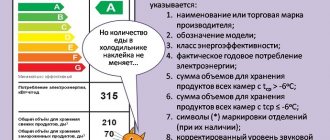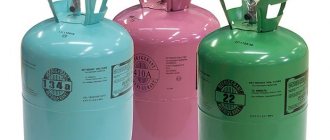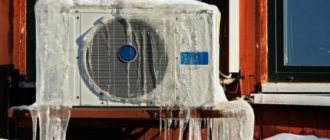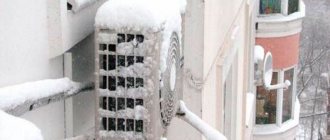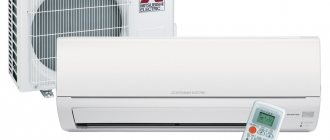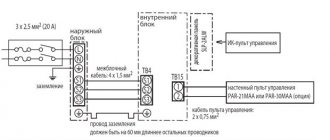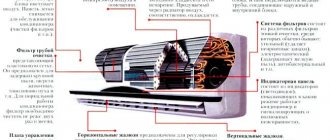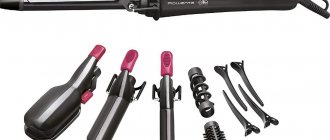Air conditioners and split systems with FREE installation
Most split systems, in addition to cooling, also work for heating. This function is especially relevant in the off-season. In private homes, the device sometimes serves as the main source of heat.
Is this heating method effective and what conditions need to be created for a split system in winter, read this article.
How does an air conditioner work for heat?
First, let's look at how the cooling process occurs:
- Freon in the form of gas enters the compressor, where it is compressed and heated to +70–90 C°.
- The hot refrigerant flows into the condenser (located in the outdoor unit), where it turns into a liquid state.
- The condensation process is accompanied by cooling of the freon with the accompanying release of heat.
- The refrigerant is then sent to the evaporator of the indoor unit, where it becomes a gas, releasing cold and absorbing heat from the room.
- Afterwards the whole path is repeated.
To start the reverse process, that is, to obtain heat, air conditioners use a four-way valve. It changes the direction of freon circulation. As a result, the external unit becomes an evaporator, and the cold is discharged outside. The indoor unit functions as a condenser in which the freon is cooled and releases heat.
Operating principle of an air-to-air heat pump
A heat pump for heating a house is designed in the same way as in a conventional air conditioner, but the functions of the blocks are opposite. The indoor unit is a refrigerant condenser, which releases thermal energy to it, due to which the surrounding air is heated, and the outdoor unit serves as an evaporator. The thermal energy itself is generated due to the periodic compression and expansion of the refrigerant in the pipes. It should be noted that the R410 refrigerant currently used does not contain freon, which means it is completely safe for the planet’s ozone layer.
More detailed information can be obtained from our managers.
What is better to warm up: air conditioning or heater
During the off-season, people most often use heaters. Their main disadvantage is high energy consumption with low output. For example, an oil heater uses 2 kW per hour at the same power rating.
Understanding how an air conditioner works for heating an apartment, it is not difficult to guess that it will be more profitable for heating. The split system does not have a heating element, and electricity is only needed to operate the motor and fan. Heat will be supplied to the room due to freon condensation. When a split system consumes 700 W of electricity, it emits about 3 kW of heat.
Basic understanding of the heating function of an air conditioner
The principle of operation of a split system for heating is to lower (!) the temperature of the air taken from the street. Air will be taken in, for example, with a temperature value of -16, and returned back in an even colder state, reaching -25. The difference is used for heat transfer: the resulting warm air enters the room.
However, does the device have enough strength to fully implement such a task? It is important to know: if the temperature outside is significantly below zero, then the compressor simply does not have enough strength to heat the air - it will begin to wear out. And if the equipment works at maximum, this is already fraught with the risk of breakdown.
So, the first condition is the temperature outside the window. Using an air conditioner as a heater is appropriate for regions with mild climates. And for most of our country, such equipment should be used only in the off-season, in the autumn or spring.
Running an air conditioner for heating in winter can be dangerous and can cause the drainage hose to freeze. In this case, condensation will begin to flow into the building. Today, manufacturers are trying to solve the problem by installing a 20-watt heater in the equipment. The locking system also works well: the equipment turns off when the temperature drops sharply.
Necessary conditions for correct operation of the air conditioner in winter
Split systems are most often used in the off-season, when central heating has already been turned off and has not yet been turned on.
Non-inverter air conditioners and inexpensive inverter air conditioners can be operated at outdoor temperatures not lower than -5-7 C°.
Middle-class inverter split systems operate at temperatures outside the window of -15 C°. Models from the premium segment can be turned on for heating even in 20-degree frost. To operate more efficiently, such devices take part of the air from the room, which allows them to compensate for smaller temperature differences. Also, in expensive models, high-quality freon flows, which boils at -30..-35, and not -18 C°.
If you only need to heat the apartment before turning on the heating, you can use an inexpensive split system. If you need to heat the room in severe frosts, give preference to more expensive models.
The operating conditions of air conditioners are specified in the operating manual. Check with the seller for the maximum permissible values to guide you when choosing a suitable device.
Features of operation in winter
To maintain comfortable conditions during the cold season without damaging the device, you must carefully study the instructions . It indicates the temperature range in which the unit is able to operate with maximum efficiency. Most often it ranges from -5 to 25 degrees.
However, in summer the unit operates at higher ambient temperatures. At the same time, its performance decreases, but it does not fail. But in winter, violation of the operating conditions of the air conditioner can lead to unpleasant consequences. In such a situation, you should understand how to turn on the air conditioner for heat while maintaining the operation of the unit.
We recommend reading: Find out how to choose an air conditioner for an apartment?
To do this you will have to understand what is happening. In most budget models, the compressor and condenser are located in the outdoor unit. If the outside temperature drops below the minimum permissible level, the oil in the compressor becomes thicker. As a result, it ceases to properly lubricate the moving parts of the device, which leads to premature failure of the unit.
When it is necessary for the air conditioner to blow warm air, the refrigerant must take heat energy from the environment and deliver it to the room. At low temperatures, freon is not able to heat up to the desired state, and then the efficiency of the unit decreases. It should also be remembered that in severe frost, phase transitions of the refrigerant fail.
If freon does not enter the compressor in a gaseous state, then water hammer is possible. When it is necessary to adjust the air conditioner to warm air, while maintaining the functionality of the unit, then you need to select the device in accordance with the operating conditions.
How should an air conditioner work for heating in winter?
If the device can operate at temperatures down to minus 20 degrees, then it can be turned on at -15-18 C°. The difference between the operating temperature and the starting temperature is 2-5 degrees. This will be reflected in the operating instructions.
The device must be warmed up before active use. For this:
- Set the room temperature parameters to around 18-21 °C and turn on the split.
- Set the blower speed to minimum.
- Let the system operate in this mode for about 5-10 minutes.
Then set the desired temperature and give the system time to heat the room.
Setup recommendations
Before turning on the warm air on the air conditioner, you must carefully study the operating instructions. Every manufacturer tries to stand out in order to attract new customers. For this purpose, some features are often introduced into the rules for using air conditioners. Thus, it is difficult to say exactly how to set the air conditioner for heat, because there are a large number of models of different brands on the market. However, there are several general points that will help solve the problem.
First way
First you need to carefully study the remote control of the unit. If it has a Mode button, then there should be no problems. It allows you to turn on one or another operating mode of the device. It must be pressed until the word Heat or an icon with a sun appears on the display. Then you will need to set the desired temperature that the air conditioner will maintain.
To do this, press the “+” and “-“ keys. You should also remember that during such manipulations the remote control must be pointed towards the unit. The last step is to confirm the settings changes. Various keys can be used for this purpose, for example ON. It is worth remembering that the air conditioner may require several minutes to change its operating mode, most often about five.
We recommend that you read: Operating instructions for the winter air conditioning kit
Second method
Often there is no Mode key on the remote control. In such a situation, you don’t have to worry that you won’t be able to put the device into heating mode. You need to carefully examine the remote control again for icons like “sun”, “droplet”, “snowflake”, etc. The heating mode is activated by the button with the first icon. Further adjustment is to set the desired room temperature.
You should also remember that you can switch the operating mode of the unit without the remote control, i.e. directly on the air conditioner. It is possible that there is no Mode or “sun” mode on the remote control. In this case, the purchased device is simply not designed to operate in heating mode. Most likely, it was an inexpensive model that does an excellent job of maintaining a comfortable microclimate in winter. If you know for sure that the air conditioner is capable of heating, but the function cannot be activated, then you should contact a service center.
Does the air conditioner wear out during cold periods?
Non-inverter models experience heavy loads in cold weather. Any system contains a lubricant that comes into contact with freon. As the temperature drops, it thickens, and in severe frosts it begins to delaminate, which can lead to breakage.
Also, thick oil does not have time to lubricate the compressor. The latter has to work with increased load, which reduces the service life.
Inverter air conditioners are less susceptible to wear and tear, as they operate constantly, periodically reducing speed. As a result, the oil circulates without stopping, thickening slightly. This results in less wear on the compressor.
If the air conditioner is designed for mild frosts, a winter kit will help minimize the risk of breakdown. It will heat the outdoor unit's pan and drain pipe, and also regulate the fan speed.
We told you how the air conditioner works in heating mode. If you have any questions about choosing a split system for all-season use, we will help you choose the right model for your home. Call us by phone or leave a request for a consultation.
Features and principle of operation of a split system for heat
To understand how an air conditioner works for heat, you need to understand how it works for cooling. After all, this is precisely the main function of an air conditioner. And it is exactly the same as that of the refrigerator. Only everything happens more intensely, because in the air conditioner the condenser is blown using a fan. This is not in the refrigerator.
The conditioner includes:
- evaporator,
- compressor,
- capacitor,
- thermostatic valve, also known as capillary tube.
It is these four devices, which are connected to each other in a ring, that are the main split system.
- The refrigerant (freon) in the form of gas is pumped out from the evaporator by the compressor.
- In it, the gas is compressed to a certain pressure, while the temperature of the latter rises sharply.
- Next, the freon moves into the condenser, which is blown by a fan. Here, thermal energy is released to the surrounding air, that is, the temperature of the refrigerant drops and it turns into liquid in the form of droplets that settle on the walls of the condenser tube. That is, the process of gas condensation occurs, which is why this device is called a capacitor. Although it is a tubular coil, like an evaporator.
- The air conditioning compressor runs constantly, so there is always a certain pressure in the system. This means that the liquid refrigerant begins to move towards the capillary tube.
- Here it begins to evaporate under pressure, turning into a gas with a low temperature, which enters the evaporator.
- In the latter, heat transfer occurs. That is, the gas takes heat from the air in the room, thereby lowering its temperature.
- The gas is then pumped out again by the compressor and the cooling process is repeated.
It should be noted that the evaporator is located in the indoor unit of the split system, the condenser is in the outdoor unit. Let us add that freon, as a refrigerant, is a material that easily passes from one state of aggregation to another, while releasing or absorbing a huge amount of thermal energy.
When the air conditioner operates for heating, the evaporator and condenser change places in terms of their purpose. That is, the coil located in the external unit will take thermal energy from the air, and the internal one will release it, because the refrigerant in it will flow at a high temperature.
Air conditioner operation in heating mode
But for this to happen, it is necessary to change the operation of the air conditioning compressor, which will not extract gas from the evaporator, but pump liquid freon into it. The technology of this process is implemented by installing a four-way valve. It simply switches the direction of movement of the refrigerant, and the compressor itself does not take any part in this. It continues to work as normal.
